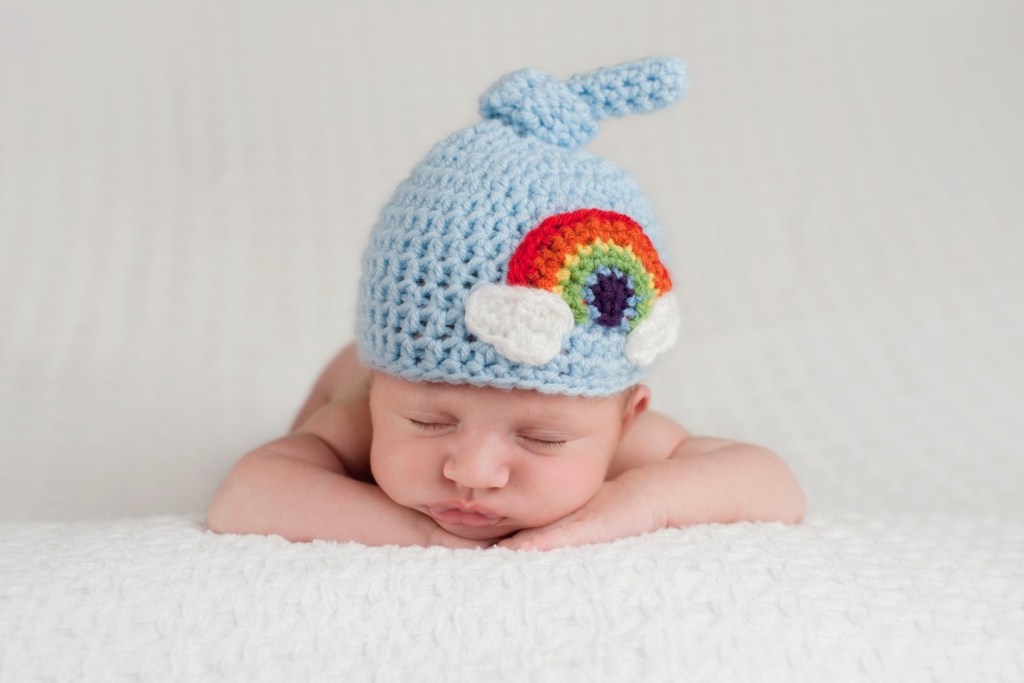
For some women, a pregnancy doesn’t end with a joyous moment in the delivery room. There really aren’t words to describe delivering a stillborn baby or losing an infant shortly after birth. Then, there are women who suffer a devastating miscarriage or multiple ones. It takes a heartbreaking amount of courage to attempt another pregnancy after a stillbirth, miscarriage, or the death of a baby. A subsequent pregnancy is filled with an overwhelming amount of anxiety, stress, and fear.
Despite that, many couples do try again and welcome a healthy baby into their lives. Even then, the fear doesn’t necessarily go away and is often accompanied by guilt. It is from the journey from the darkness to the light where the term rainbow baby was born. What is a rainbow baby? In order to understand what a rainbow baby is, it’s helpful to explore the origin behind the term.
What is a rainbow baby?

For many years, discussing a stillbirth, miscarriage, or even the death of a baby was considered taboo, even among family members. It simply wasn’t talked about, which didn’t exactly help with the healing process for the grieving parents.
In 2008, the term appeared in a collection of short stories by Christie Brooks: Our Heartbreaking Choices: Forty-Six Women Share Their Stories of Interrupting a Much-Wanted Pregnancy. These books touched on the journeys of women who decided to have an abortion because of prenatal or maternal medical complications. It originates from the idea of the uplifting rainbow that often miraculously appears in the sky following a storm.
Rainbow baby quickly spread to internet forums and support groups for parents grieving over the loss of their child(ren), and thus became a term regularly used among families and friends, eventually making the transition into pop culture and the media.
National Rainbow Baby Day
A decade after Brooks’ short story collection was published, Alexis DelChiaro took the term rainbow baby and established a day to celebrate it. DelChiaro is the founder of the newsletter What the Fertility. The newsletter/blog is devoted to providing women suffering from infertility a forum. The former morning television host battled with fertility issues before the birth of her two children just five and a half months apart.
In 2018, DelChiaro founded National Rainbow Baby Day on August 22 to honor the memories of those infants lost, as well as to celebrate motherhood and the healthy babies born out of loss. Having a National Rainbow Baby Day annually helps take the taboo away from stillbirths, miscarriages, infant death, and the infertility difficulties many women face along the road to motherhood. While a rainbow baby, of course, brings happiness, many mothers and fathers suffer from anxiety, fear, and guilt.
Breaking the stigma

While not only giving a name to what can only be described as a terribly painful and gut-wrenching situation, and the beauty that can unfold out of such a tumultuous time, rainbow babies, and the celebration of their arrival has helped break the stigma and barriers of infant loss. Until the mid-2000s, discussing the loss of a child or pregnancy was avoided even in close family circles.
Creating and developing a term that parents and supporters can use when describing a terribly strenuous time in a grieving parent’s life breaks the chains of silence on infant loss and allows parents to heal without feeling invalidated or “broken” in some way.
Losing a baby, no matter how the loss occurred, is not a blight on the parent. Loss of life can very often be out of the hands of those it comes to touch, and too often, parents are blamed for creating their own tragedy without thought of what those kinds of words could do to a parent in grief. Now more than ever, moms and dads who have had to bury a child or carry out a procedure to end their pregnancy need encouragement from others to keep going, with the possibility of their rainbow baby just within reach.
In addition to National Rainbow Baby Day in August, October is Pregnancy and Infant Loss Awareness Month. Having a special day each year to remember loss and celebrate a rainbow baby, as well as a month to raise awareness about the number of couples who deal with pregnancy and infant loss helps break that stigma of silence.
How to use the term in support

Perhaps you have a friend, family member, or co-worker who has recently suffered the loss of their child in some way or another. That person bore the weight of their loss and grieved. They then were overjoyed to learn that they were once again pregnant with their very own rainbow baby. By acknowledging the term and showing your friend that you see, recognize, and appreciate their situation, you can open the door to a deeper connection and bond between the two of you, while also highlighting their light after the storm.
Additionally, parents who have suffered loss and vocalize their grief, and eventually their joy of new life after loss, help keep the cycle of awareness and respect moving forward. By using open discussion, acknowledging the loss suffered, and the hope — or already achieved delight — for the future, parents can keep perpetuating understanding and attention to infant loss, while also showcasing the happy times that can come from the ashes like a phoenix.
So, whether you yourself are grieving, have grieved, or know someone currently suffering from the loss of a child, you equally understand the levels of sadness that can go hand in hand with that loss. It is our greatest hope that you also have seen or personally experienced the bliss of bringing life into this world. After such a catastrophic and undeniably cataclysmic event, your very own rainbow baby can show you that beauty is very much possible, even after the most painful and hellacious storms out there. By keeping the term rainbow baby out in the universe, sharing photos, moments, and experiences, you are fanning the flames of openness and the ultimate acceptance that life is precious, and sometimes support is needed by those around us.



